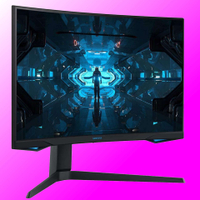Watching Doom being played on a hologram-like volumetric display is like taking a peek at the future of gaming
But let's hope the future involves less noise and more pixels, yes?
The original Doom is a landmark in the history of PC gaming. Hardly news, of course, but its enduring popularity over the past three decades means that it's also the piece of software that one must use when experimenting with coding or electronics projects. When I saw it being played on a volumetric display, though, it didn't generate any feelings of nostalgia—I saw the future of PC gaming.
If you're wondering just what a volumetric display is, it's a device that consists of a strip or array of LEDs that get rapidly rotated. The image created by the lights changing in a streamed pattern then fills a volume in front of you. In other words, it's like a holographic display (think Star Wars).
A YouTuber going by the name Ancient has been seemingly obsessed with getting Doom to run on all kinds of little gadgets and displays, but their recent adventures with a volumetric display have been genuinely intriguing. I first saw their attempts at 'volumising' Doom a couple of months ago but a recently posted video showed just how much progress the modder has made.
There are some obvious limitations, though, with the most notable being that the draw distance in the game (how far into the world you can actually see) is directly proportional to the size of the volumetric display. Ancient's homemade system is quite small so it does make the draw distance very short, worse than the first 3D games on the original PlayStation. You can see how the actual game and the display compare in this video.
Something else that's quite limited is the resolution of the display. While it would be easy enough to add in more LEDs, to increase the number of pixels (or should that be voxels, given the nature of the display?), that just makes the whole thing more complex to program and possibly heavier too, with the extra circuitry required.
Lastly, there's the issue of noise—the motor that drives the rotation and, when the plastic dome is removed, the whooshing of the air as the display whips around are both quite distracting.
But these are all perfectly understandable and I don't mention them as criticism of what Ancient has managed to achieve. Their work is all self-funded and homemade, and it's all very impressive. If you want to see what's possible when there's a lot more money involved, then check out the Voxon VX2 display, yours for a mere $6,800. Actually, that doesn't seem hugely better than this Doom demonstration.
The biggest gaming news, reviews and hardware deals
Keep up to date with the most important stories and the best deals, as picked by the PC Gamer team.
Anyway, while we're not going to be swapping our high-resolution gaming monitors for a spinny-whirry globe just yet, I dare say that this could well be a glimpse at what the future of PC gaming holds for us. Now all I need is space to have a volumetric display big enough to show off the full draw distance in Doom. Time to rip and tear!
Best gaming monitor: Pixel-perfect panels.
Best high refresh rate monitor: Screaming quick.
Best 4K monitor for gaming: High-res only.
Best 4K TV for gaming: Big-screen 4K PC gaming.

Nick, gaming, and computers all first met in 1981, with the love affair starting on a Sinclair ZX81 in kit form and a book on ZX Basic. He ended up becoming a physics and IT teacher, but by the late 1990s decided it was time to cut his teeth writing for a long defunct UK tech site. He went on to do the same at Madonion, helping to write the help files for 3DMark and PCMark. After a short stint working at Beyond3D.com, Nick joined Futuremark (MadOnion rebranded) full-time, as editor-in-chief for its gaming and hardware section, YouGamers. After the site shutdown, he became an engineering and computing lecturer for many years, but missed the writing bug. Cue four years at TechSpot.com and over 100 long articles on anything and everything. He freely admits to being far too obsessed with GPUs and open world grindy RPGs, but who isn't these days?



